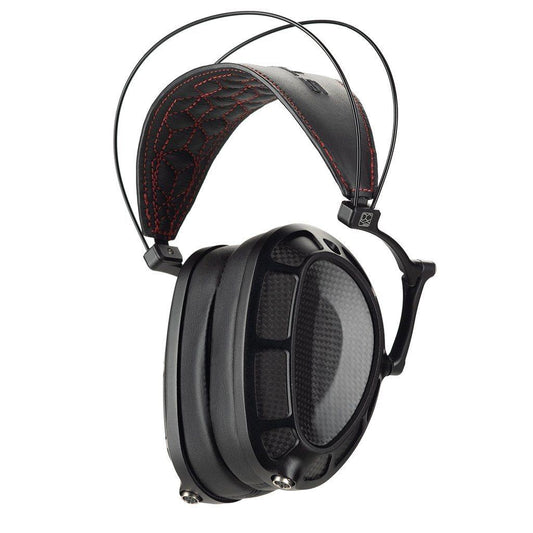Dan Clark Audio Stealth Planar Closed-Back Headphones Review
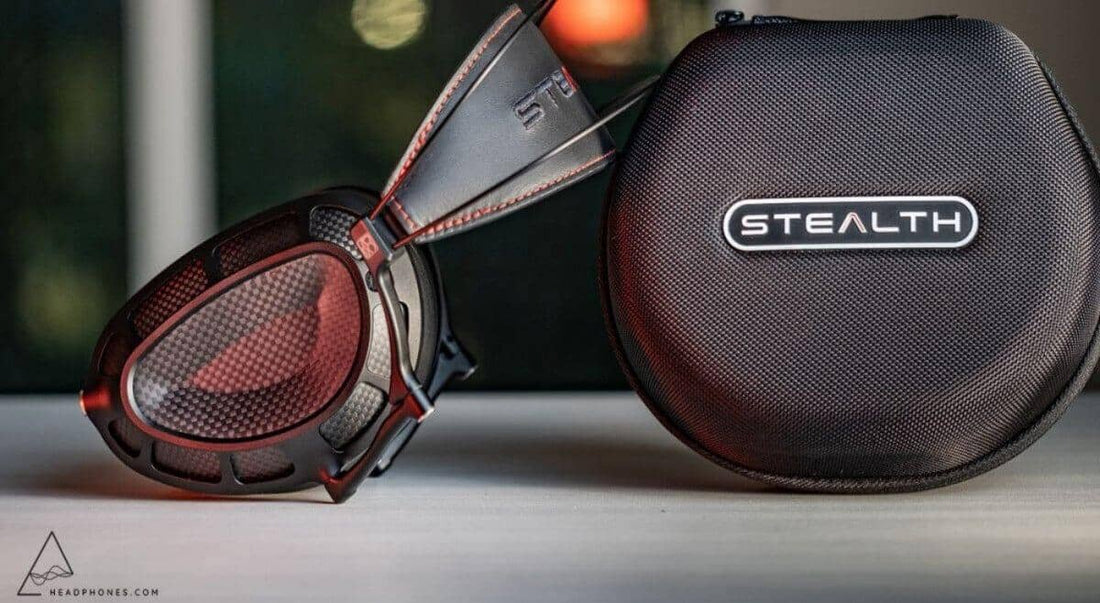
Introduction
Dan Clark Audio have recently entered into the ultra flagship summit-fi space with their brand new Stealth closed-back planar magnetic headphone, which features their newly innovated Acoustic Metamaterial Tuning System (AMTS) technology.
The Stealth comes in at a whopping $4000, which is a considerable step up in price from the rest of their planar magnetic headphone lineup so far, with the closest being their open-back Ether 2 at approximately $2300. Those familiar with the high-end headphone world, however, won’t find these high price tags all that shocking, and there’s notable competition at this price range from the likes of the Focal, HiFiMAN, Abyss, Audeze, and Final Audio to name a few.
With that said, the Stealth is one of only three closed-back planar magnetic headphones to command this kind of summit-tier price tag, the other two being the HiFiMAN HE-R10p ($5500) and Kennerton Rognir ($3500). The Stealth also stands out in a number of other ways, specifically when it comes to form factor - this is also a portable headphone, while most other summit-tier flagship headphones are not.
In this review, I examine the DCA Stealth and compare it to other flagship headphones around its price, as well as DCA’s other headphones for those who are already familiar with them. To give a bit of context for my preferences, I absolutely loved the Aeon 2 Noire (perforated pads), and have personally owned a set of Aeons in the past. At the same time I wasn’t a fan of the Ether 2’s sound signature, even though it’s quite comfortable. Now, let’s see how the Stealth stacks up.
Dan Clark Audio Stealth Headphones
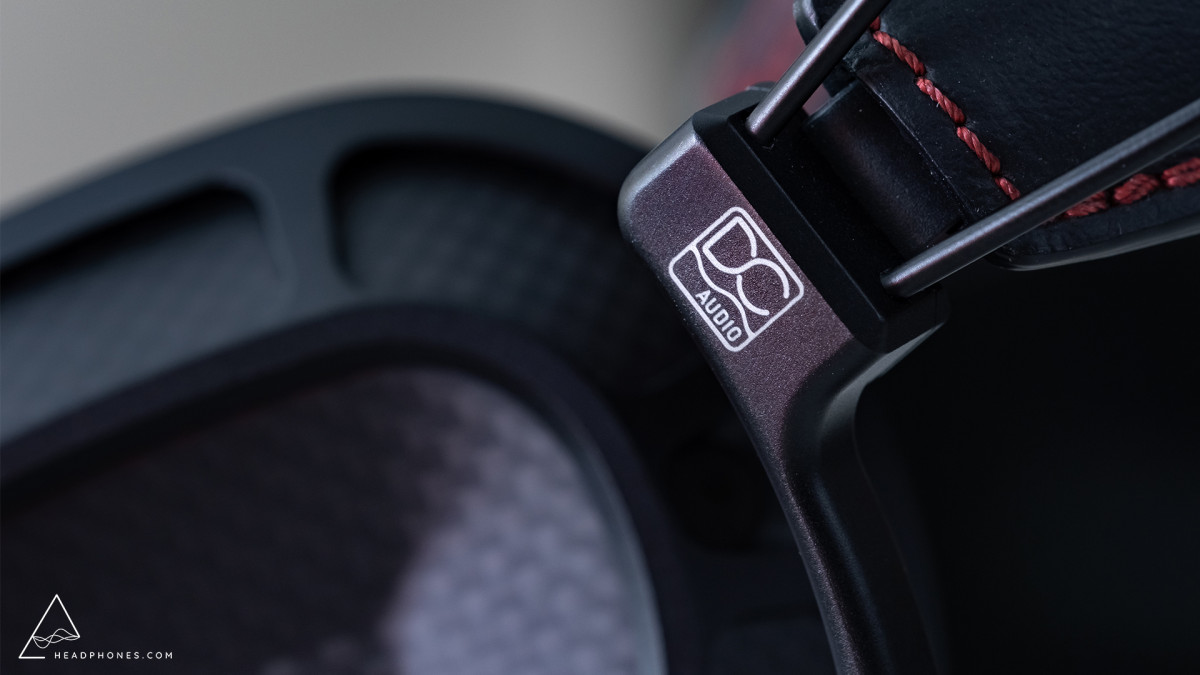
Specs
- Weight: 415grams
- Impedance: 23 ohm
- Sensitivity: Approximately 86 - 87 dB/mW
- Driver: 72mm x 50mm single-sided planar magnetic.
- Driver matching: 0.25db weighted 20-10,000Hz.
- Carry Case: Included
- Headphone Connectors: Hirose - VIVO cable included
- Misc: Acoustic Metamaterial Tuning System
- Price: $4000
Sources
While the Stealth is fairly low impedance, it also has somewhat low sensitivity, meaning that while this headphone has a portable form factor and carry case, you definitely want to run this headphone with an amplifier. I also recommend running it from a balanced output when possible (at least for the added power benefits when that’s the case). For me, I ran it with either 4pin balanced XLR, or with a balanced 2.5mm termination adapter to the balanced output of a DAP. With that said, these were the sources I ran the Stealth from, in most cases with the balanced output.
- SMSL SU-9 DAC
- Soncoz LA-QXD1 DAC
- iFi Pro iDSD DAC/Amp
- iBasso DX220 DAP
- Topping A90 Amp
- Cayin IHA-6 Amp
- SPL Phonitor X Amp
- Vioelectric HPA V550 Amp
- Burson Conductor Amp
Build, Design & Comfort
For some time now, DCA has been at the forefront of innovative headphone design. In particular, it’s very obvious that both comfort and use case are a priority, and this is no different with the Stealth. Just like the Aeon 2s and the Noire, the Stealth retains the backside collapsible single-yoke design that allows it to fold up into a small, portable case. This is a fantastic design that makes the Stealth easy to throw into a backpack and take on a trip - for those willing to take their expensive high end headphones on the go.
It helps that just like the rest of DCA’s lineup, the Stealth is built impeccably well. The housing construction is a combination of carbon fiber and machined aluminum. The headband is made of leather, but instead of their previous single-band style attachment up top - where you had to manually slide the strap up or down - the Stealth employs an elastic suspension system that I much prefer.
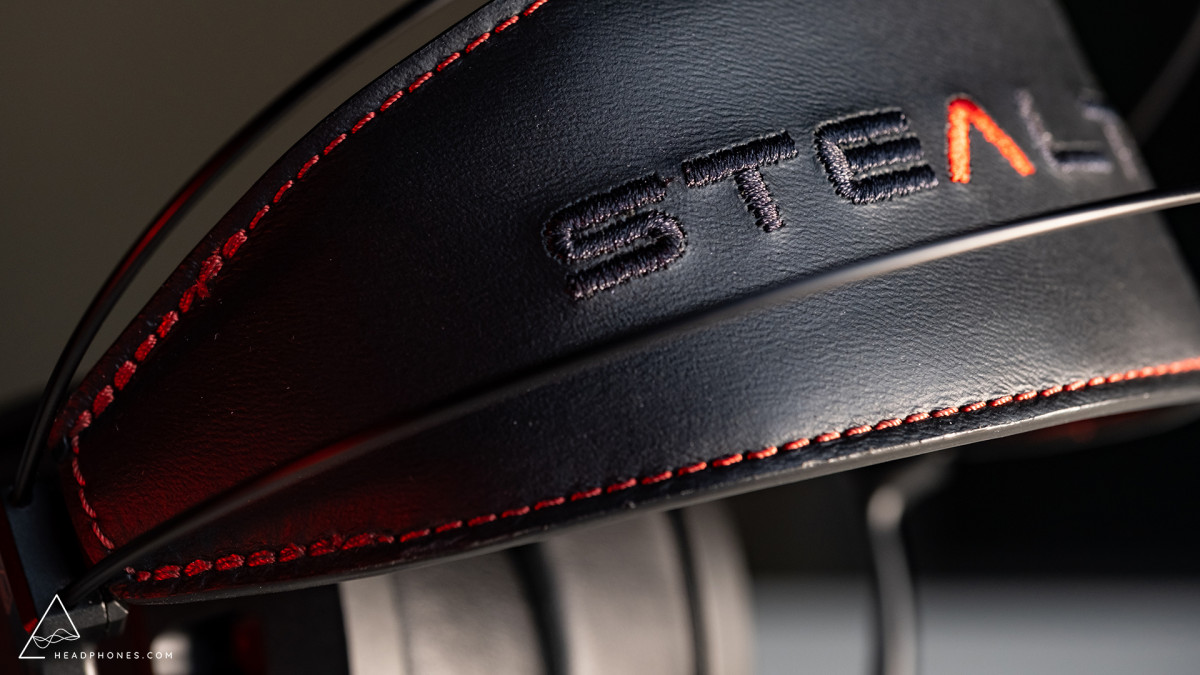
The result is a snug, yet comfortable fit overall. Importantly, the Stealth is reasonably lightweight at only 415g. While this is heavier than their previous models, it’s still a far cry from the typical 600-700g flagships it's competing with. I had no trouble getting through a full day of work wearing the Stealth, while many other summit level flagship headphones are more suited for shorter listening sessions.
For me there were two things to note for comfort, one is that there was mild pressure where the bottom of the cups would come into contact with my jaw, although it may be alleviated by rotating the headband forward slightly. The second was that the back part of my ears would come into contact with the AMTS waveguide piece on the inside of the cup from time to time. While not really an impediment to comfort, this is something I noticed and felt was worth documenting.
Isolation
The Stealth’s snug fit does a fantastic job of isolating the music from sounds in my surrounding environment. While it’s not going to be on the same level as an ANC headphone, it had no trouble isolating me from nearby voices or the hum of the air conditioner. Additionally, little to no sound leaks out, so you won’t disturb your neighbours when listening at common volume levels (around 80dB). The key thing for this evaluation is that the Stealth did a better job at isolation and leakage than the other closed-back headphones I’ve been comparing it with, namely the Audeze LCD-XC, and the Focal Stellia. But this will also depend somewhat on fit.
Now, let’s talk about how the Stealth sounds.
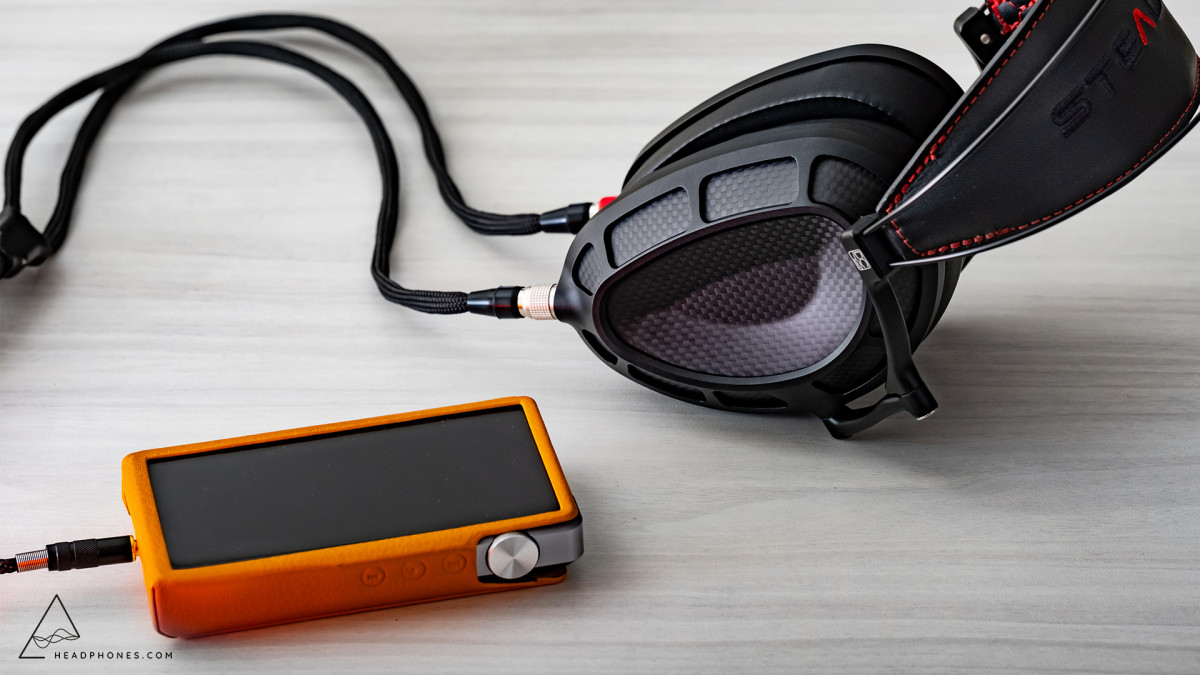
Objective Findings:
The DCA Stealth has a number of notable sound-related features and improvements over its predecessors. Namely, it uses a 20% larger diaphragm when compared to the Ether 2, and rather than using their previous foam insert tuning filters, the Stealth uses a new patent-pending Acoustic Metamaterials Tuning System or AMTS.
It can be very difficult to get the tonal balance right with a closed-back headphone, and closing off the back of a planar magnetic transducer like what the Stealth uses can be even more challenging. There are a number of solutions to this, usually involving some sort of driver damping - and indeed DCA’s previous tuning inserts were another way of doing that. But in my opinion DCA’s new AMTS is a much better solution to achieving the desired sound for a closed-back planar magnetic headphone than the previous tuning filter concept. So what is it?
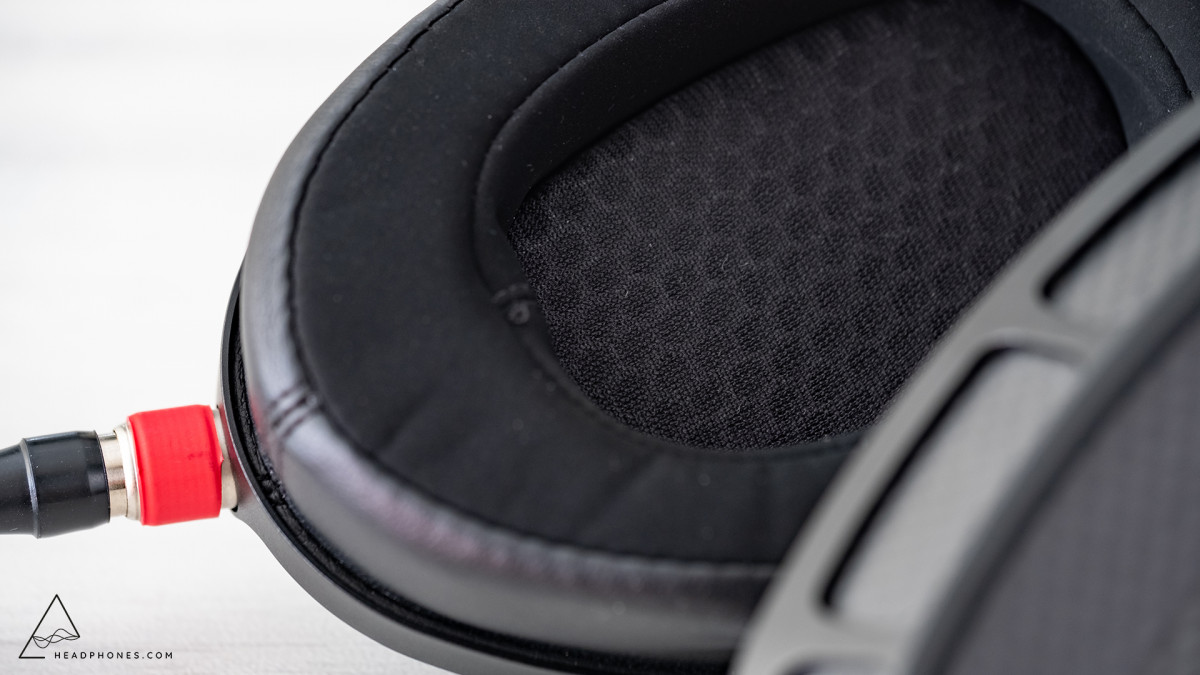
AMTS is a piece of material that fits between the driver and the ear, and functions as a sophisticated tuning structure that includes waveguides, diffusion control, quarter-wave, and Helmholtz resonators. Effectively this allows for a much more surgical approach to tuning the headphone, and solves the problem of any resonances or standing waves introduced by closing off the back of the headphone. I’m also told that this tuning system mostly affects frequencies above 4khz, which can be the most tricky part of the tuning to get right. So how does the Stealth and the new tuning solution sound?
Tonal Balance & Frequency Response
The following is how the DCA Stealth measures on the GRAS 43AG with anthropometric pinna relative to the combined version of the Harman preference target (2013 bass, 2018 mids and treble). This reference point is suitable for most listeners looking for an even spectral balance from their headphones.
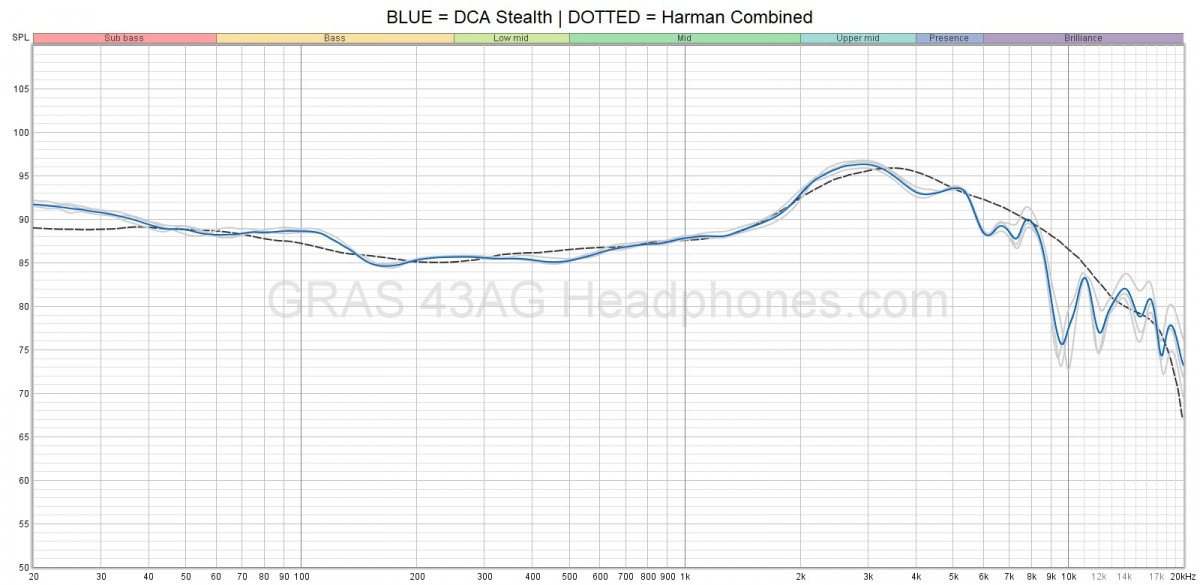
How do you read this? The dotted black line is the target (the reference point), and the colored line is how the headphone in question measures. Effectively, this shows how significantly the headphone’s frequency response deviates from the target. It’s important to note that because the target is highly smoothed, there are places where deviation is required (like at around 9khz for example).
In short, this is an excellent result. The DCA Stealth is undoubtedly one of the better measuring headphones I’ve ever come across at any price point. While adherence to the target isn’t the only thing that constitutes ‘good sound’, this certainly represents an exceptional balance between fundamental and harmonic tones (this is key). Speaking with DCA on the idea behind the Stealth’s tuning, it was indicated that they didn’t specifically set out to make something that matched the Harman target, however over the years of development working on AMTS, they found this to be the right result.
Regardless of the intention, the Stealth absolutely nails the various features of the Harman target. So what does that mean? Well in a word, clarity.
Now, before diving into the specifics, it’s worth mentioning that there are a number of other lower-priced headphones that also get very close to the Harman target - in particular the AKG K371. While the K371 is a much lower-end headphone, it also demonstrates the benefits of achieving an excellent tonal balance. And, while it’s not the most technically impressive headphone, its tonal balance allows for a kind of ‘unveiling’ of the details in the music. The DCA Stealth’s tuning has a similar ‘unveiling’ effect, with much more impressive technical performance, and the reason why I have to stress this point is that this quality is a major contributor to overall sound quality.
Bass
The sub-bass and bass are appropriately elevated, and then importantly the shelf comes down in the upper bass below 200hz. You’ll also notice the dip, or as I like to call it the ‘Harman contour’ between the upper bass and lower mids. Interestingly this just happens to be where listeners were able to adjust bass levels in the research that was done to develop this target. Some may desire more body and richness of tone in the contoured area, but I really enjoy that the bass level is satisfying without bleeding or intruding into the mids - and that contour is what gives this headphone such good clarity in the midrange.
One interesting thing to note is that the measurements show a slight bump or feature in the mid-bass, but I’m told that this was done with the intention to compensate for the Stealth has remarkably low harmonic distortion in the bass in order to make it sound a bit more natural.
As with most closed-back headphones, bass level on the Stealth is also dependent on coupling integrity, as the driver resonance frequency for this headphone is fairly high at around 300-400hz, meaning that if you break the seal for one reason or another, you’ll lose bass level below that. But with that said it wasn’t difficult to achieve the required seal to get the intended bass response.
Here’s the air gap behavior: Green = small leak (glasses with acetate frames being used), Orange = large leak.

In my testing I found that even though I wear glasses (with thinner arms), I was able to get a good seal with appropriate bass response.
Here’s the Stealth measures for bass on my head, using an in-ear mic to test:
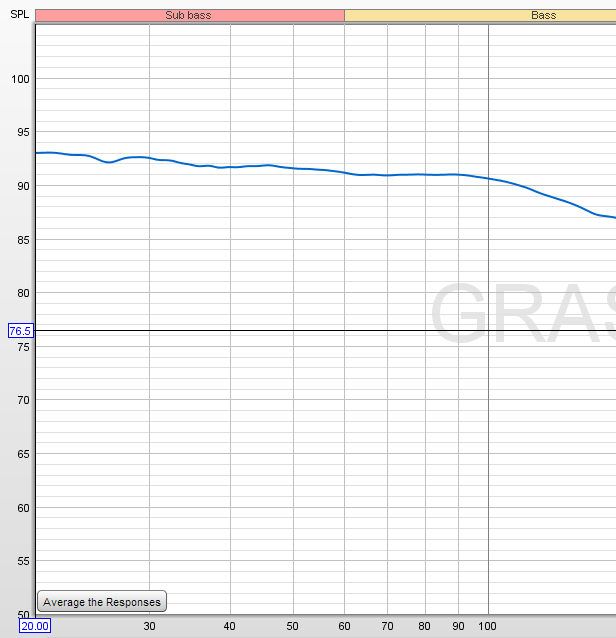
In general this is a somewhat expected result for the on-head measurement, as it matches what the industry standard GRAS measurement rig shows for the bass, however for those who aren’t getting the full bass response, it could be due to some positioning issue or glasses with thick frames/arms.
Mids
In some ways the Stealth’s mids stand out to me above the rest. On the one hand, they border ever so slightly on the line between clarity and shout for me, somewhere between 2-3khz, with certain recordings it can be a touch hot or a hair forward. While this is by no means a headphone that needs EQ, this may be where I drop it by a few dB depending on the genres or recordings I’m listening to.
With that said for well-recorded music you likely won’t need to do this, and it’s perfectly agreeable for jazz, classical and acoustic tracks, but for music with electric guitars, this range can occasionally come across a bit too strongly. Some have also been partial to a deviation from the Harman target in this region, even though in my opinion an elevation here is a requirement. In short, the Stealth is very close to ‘accurate’ throughout the midrange, but I can also see reasons why someone would want it to be more relaxed with certain music specifically around 2-3khz.
It should also be noted that this upper midrange feature does change depending on the positioning. In a recent forum post, DCA confirmed this, suggested that listeners try to position the headphone such that the back top part of the ear (around 10 o’clock) touches the rear of the ear pad at that spot, and this matches how I hear the difference as well.
Treble
The best way I can describe the Stealth’s treble is ‘appropriately relaxed’ - and I don’t mean that in a bad way. It seems common for flagship planar magnetic headphones to go-for-broke with upper treble extension. While the perception of this quality as positive or negative will likely depend on the age of the listener, I tend to find the upper treble boosts you see on headphones like the Audeze LCD-4 or the HiFiMAN HE1000se to be somewhat of a party trick - something that’s exciting initially but not particularly realistic. By contrast, the Stealth doesn’t do any of that. It’s fully-extended, without the upper treble boost. I could see wanting a bit more sparkle and brilliance in general, but the important thing here is that the treble comes down appropriately to avoid that typical ‘shimmer’ or upper air boost that’s common with high end planars.
This creates an emphasis for the focus of cymbal hits, rather than their more ethereal or ‘splashy’ upper harmonics. Moreover, the mid-treble is also somewhat relaxed, meaning it doesn’t overemphasize the sibilant tones like ‘S’, ‘F’, and ‘T’. This is also why to me it sounds ‘appropriately relaxed’ in the treble. There is, however, one minor downside to this relaxed mid-treble. Remember that ever so slightly hot upper midrange? The relaxed mid-treble is one of the reasons why it can come across this way - again depending on the headphone’s positioning on the head.
Now, that might sound strange, but we have to remember that the perception of tonal balance is more than just hearing one range or another. Good tonal balance can be summed up as an appropriate balance between fundamental tones and their resonant harmonics - in a similar manner to how those tones would come across in real life. And, as mentioned, the Stealth generally nails this balance, but that slightly relaxed mid treble has the effect of making those upper midrange tones a bit more noticeable on certain recordings. So as much as it’s not necessary to EQ anything on the Stealth, I think you could either boost the mid-treble a touch, or reduce the upper midrange by a few dB. Otherwise, the only remaining limitation would be the quality of the recording you’re listening to, and the Stealth will reveal that as well.
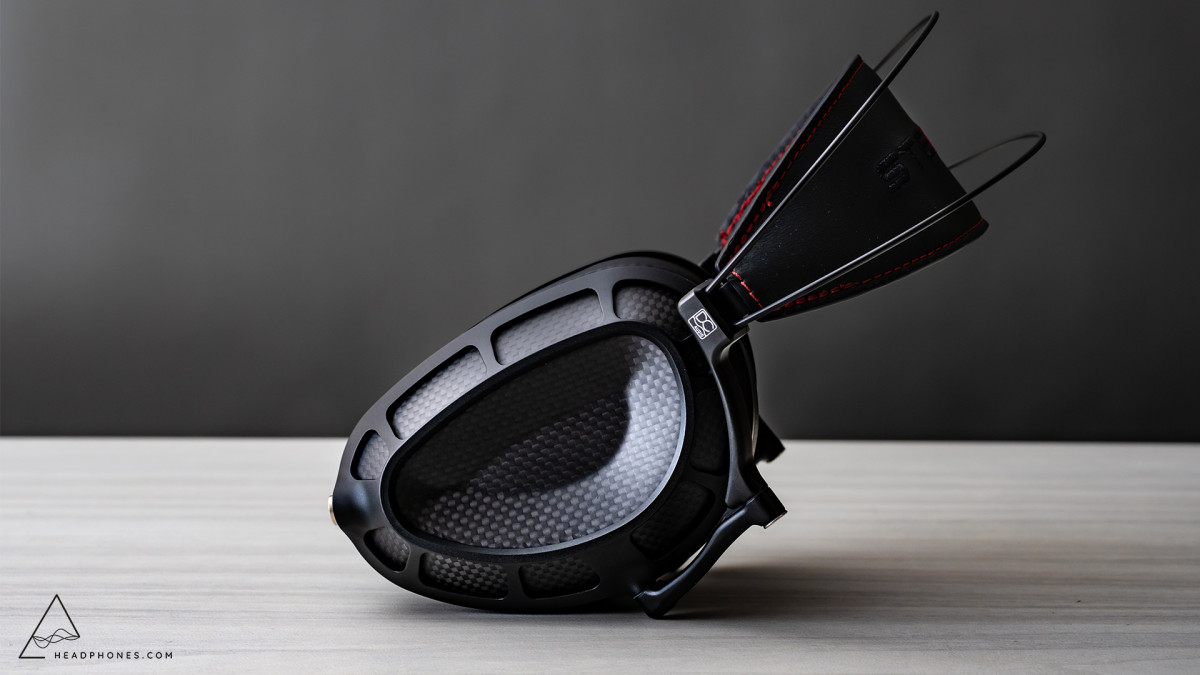
Subjective Findings
Detail
When it comes to the perception of detail with the Stealth, it requires a bit more of a nuanced explanation than to simply say “it’s good”, because it is good - there’s just more to it than that. When I listen for detail, there are two key aspects that I try to pay attention to, and note that this isn’t something that’s currently analyzed in terms of frequency response or other common metrics (including THD).
The first part of how I evaluate detail involves assessing the balance between immediacy of the initial leading edge and the clarity for trailing ends of tones - in similar fashion to the way Crinacle has described his analysis of this quality . This contributes to both the ‘tightness’ or ‘speed’ aspects of the headphone and determines if there’s any bluntedness going on. When a headphone doesn’t have good clarity for trailing ends of tones, it can sound as if the nuances that exist in the music there (or would exist there on other headphones) are simply lopped off, and this can sound like the absence of detail, or ‘blunted’ for those nuances.
For this first aspect, the Stealth sounds reasonably quick for its initial leading edge, and also not at all blunted with good clarity for its trailing ends of tones. When I compared it against the open-back DCA Ether 2, I found the Stealth to be even slightly more clear for this quality. With that said, compared to other flagship headphones around the $4000 price mark (generally open-back headphones), for this quality the Stealth is still a step behind to my ear. What helped reveal this was doing somewhat of an apples to apples comparison because the Stealth’s tuning is very close to how I EQ most other headphones anyway.
For the second aspect of detail perception, or at least how I evaluate it, the Stealth is absolutely competitive with other flagship headphones. To me, the other key contributing factor is how well a headphone does at instrument separation and distinctness - especially during busy passages. A good result here generally means that you can hear each individual line in your music very clearly, as opposed to having them blend together into a big wall of sound. And once again, this is really where the Stealth shines, partially due to the fact that it’s a planar, and high performance planar magnetic headphones typically do well here.
So how good is the Stealth for ‘detail’ and ‘resolution’? Any judgment about this will depend on which quality you value more, but I would summarize it like this: it’s good, but also not at the very top.
Soundstage/Imaging
At first I was a bit thrown off by the Stealth’s presentation of space and stage because of how well separated all the images are in the mix. However, after spending more time with it and doing more comparisons, I find the Stealth to occasionally have a somewhat intimate presentation. In particular, it seems to have a unique range of image placement from near to far. Quite often I would hear vocal lines very close to me and intimate, while the rest of the mix would be farther away in the background for example. So this is an interesting depth quality that some may like but others may find a bit distracting. Additionally, the Stealth seems to have quite a good sense of depth presence, making it very easy to look forward into the various layers and instrument lines in the mix.
Another aspect that threw me off initially with the Stealth is that it doesn’t have that occasionally ‘closed-in’ kind of sound that most closed-back headphones tend to exhibit. I have to imagine that part of this comes from the use of the AMTS technology that solves the issue of certain resonances and standing waves incurred by closing off the headphone. But regardless, the perception is one of a more ‘open’ sounding closed-back than I typically come across.
Dynamics (contrast)
This is a bit of a controversial subject, since not everyone seems to notice this quality or fully understand what it describes - partially because the term often gets confused with ‘dynamic range’, which it’s not meant to describe. Some call it ‘slam’, some call it ‘macrodynamics’, Tyll Hertsens called this quality ‘punchiness’... but many listeners across a wide variety of communities do seem to notice this quality, and it is something that I notice as well.
Importantly, this quality does not appear to be correlated with bass level in any consistent fashion - when you look at the full landscape of high end headphones, there are too many counterexamples for headphones that both have and lack this quality to be able to point to any existing metric that can predict it.
In any case, the perception is of a kind of physicality or contrast - something that’s almost felt as much as it is heard. When headphones have this quality, they exhibit a kind of intensity and potentially even an aggressiveness, while its absence leads to a softer and flatter presentation overall - but not one that is universally undesirable. If you think about the presentation of the egg-shaped HiFiMAN headphones, like the Ananda, Arya, and HE1000 series, they’re all a bit on the softer side while being generally well-received.
To my ear, for this quality the Stealth sits comfortably on the softer side of things as well, even if not as compressed as some of their lower end headphones. Moreover it does compensate for that softness with an elevated bass response (particularly in the sub-bass, matching the Harman shelf). So while it might not be as intense as something like an original HiFiMAN HE-6, or a Focal Utopia, the Stealth’s bass level is significantly elevated over those headphones, and this gives it satisfying definition down low. Still, this is not something that’s going to take your head off with its physicality or intensity, and so those looking for this quality or those who might be uniquely interested in it should probably look elsewhere.
Comparisons
Audeze LCD-XC ($1300)
Also a closed-back planar magnetic headphone, the LCD-XC is perhaps one of the best value closed-back headphones when you add a touch of EQ to the mix (it really benefits from a bass boost, and it's impressive what it can handle), however with the Stealth, no EQ is necessary. So the Stealth has the tuning advantage. It’s also got an instrument separation and control advantage, even though the XC is great there too. Moreover, the Stealth is way lighter and much easier to wear for long sessions. With the XC, my neck gets sore after a couple of hours, and with the Stealth I don’t have that issue.
Focal Stellia ($3000)
The Stealth has an advantage over the Stellia for its tonal balance and overall clarity. It’s also more ‘open’ sounding in general. For detail, they’re pretty close, depending on which aspects you value, however I also have to give the image separation edge to the Stealth. The key area where the Stellia has a noticeable advantage is in its punchiness and macro contrast, for those who are looking for this quality.
ZMF Verite (~$2500)
Unfortunately I don’t have a Verite Closed on hand to compare, but there are some similarities between the closed and the open as they use the same driver. For tonal balance, compared to the open-back Verite, the Stealth is definitely less ‘flavor’ oriented, and in some sense gives a more tonally ‘normal’ presentation. The Verite is on the whole quite a bit warmer, with less ear gain around 3khz. In this way the Stealth has kind of the opposite presentation, emphasizing clarity for that region. For detail, it’s fairly close, much like with the Stellia, but again the Stealth wins for instrument separation and control. The Verite also has the advantage when it comes to ‘slam’ or that macro contrast quality.
Focal Utopia ($4400)
Just like the Stealth, the Utopia also has an excellent tonal balance. For me the Stealth has a slight tuning edge over the Utopia by being smoother in the treble, but in general they both achieve a solid balance between fundamental and harmonics for instrument tones. With that said the Utopia has a clear advantage for punchiness and macro contrast, even though the Stealth is more elevated in the sub-bass. The Utopia also has slightly better clarity for trailing ends of tones. On the other hand, the Stealth is at least as good if not slightly better than the Utopia for instrument separation and control during busy passages. The Utopia is one of the very best dynamic driver headphones at this quality, but I find that Planars simply do that better at the high end.
DCA Ether 2 ($2200)
I find the Stealth to be better for just about every aspect of sound quality (except maybe soundstage) when compared to the Ether 2. The Ether 2 has a somewhat esoteric tuning - even when swapping to the perforated pads, which add quite a bit of mid and upper bass bloom. So the Stealth is quite a bit more pleasant for its tonal balance to my ear, even if again some may be looking for the Ether 2’s warmer presentation. Additionally, for detail, separation, incisiveness, and contrast… the Stealth simply sounds better to me. In my opinion, there are only two advantages the Ether 2 has over the Stealth. One is weight/comfort, and the stealth is also good there, and the other is soundstage, with the Ether 2 being a bit wider.
DCA Aeon 2Noire ($900)
I’ve spent quite a bit of time with the Noire and comparing it against the Stealth, and I keep coming to the same conclusion. The Stealth to my ear is very much like a turbo Noire. It improves on and refines all aspects of the Noire’s sound, but there is a definite similarity between the two.
They’re both portable, lightweight, comfortable, with good detail and tonal balance. Where the Stealth turns it up a notch is in terms of its image distinctness and separation - and an even more balanced frequency response. As much as it’s already quite good without EQ, I do make some adjustments with the Noire, and with the Stealth I don’t have to - at least for the music I most commonly listen to. Moreover, as mentioned earlier, the Stealth’s AMTS allows it to do an even better job than the Noire at getting the tonal balance right, particularly in the upper midrange and treble, and without the need for any of the foam insert filters - although I didn’t find the Noire really needed them either. So the Stealth is definitely better, but the Noire is only 1/4th the price.
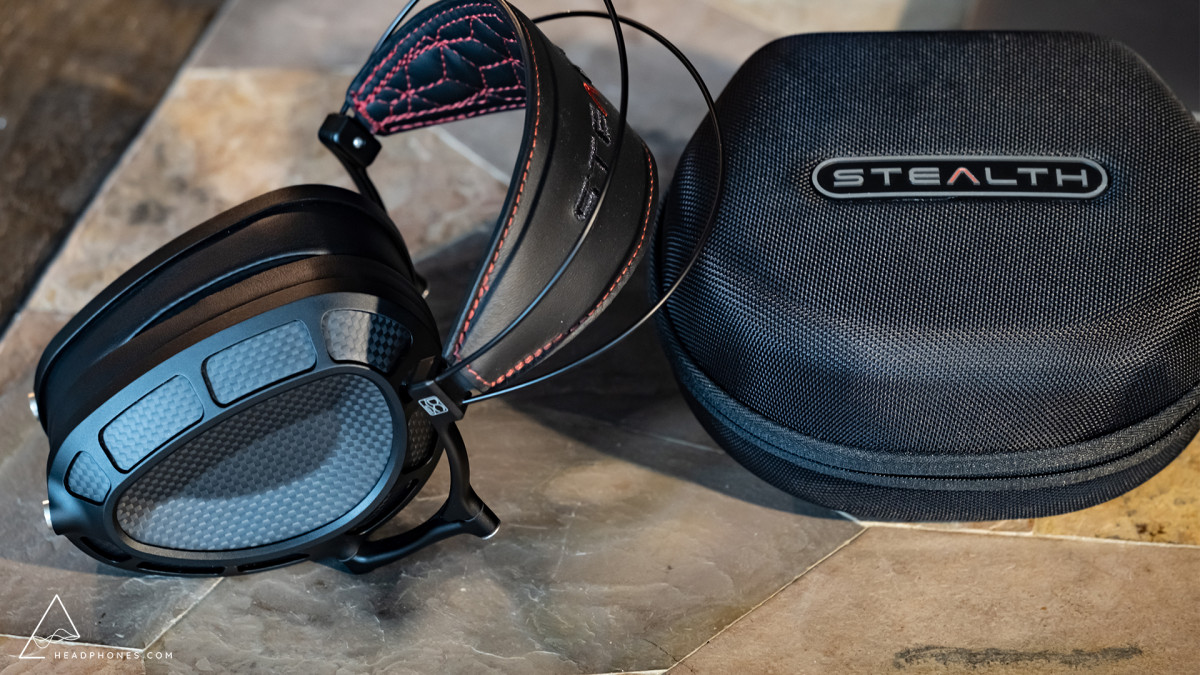
Conclusion
The DCA Stealth is a bit of a tricky headphone to give a definitive conclusion on, because how it's received or appreciated will largely depend on what the listener values. For those who uniquely care about technical performance like detail or spaciousness at any cost, then this price tag can get you something more impressive. However the tradeoffs are often significant, both when it comes to the most meaningful contribution to overall sound quality (frequency response) as well as form factor for long-term comfort or use case concessions (open-back vs closed-back).
There’s also the consideration that there really isn’t anything else like the Stealth on the market at the moment - namely a summit level flagship closed-back planar magnetic headphone that’s lightweight/comfortable and also has a great frequency response. Traditionally, high-priced headphones have been able to command their place at the summit-fi table largely as a function of their technical prowess. And, while the Stealth is fine in this regard - even if it’s not the best available - in my view it's the Stealth’s tuning and form-factor successes that are the more important things to consider. I find that we often lose sight of how important these two factors are for overall enjoyment.
To underscore this point, it should be noted that the Aeon 2 Noire (perforated pads) also achieves an excellent result for these same aspects, even if it’s to a lesser extent than the Stealth does. So the question really comes down to how much you care about getting the last level of detail - the last level of tonal balance - in a closed-back planar magnetic headphone. While the Stealth is without question a noticeable step up from the Aeon 2 Noire, if you don’t need the very best available in a closed-back planar magnetic headphone, the Noire is already a fantastic option at a much more accessible price point.
However, with that said, I’ll leave you with this: the Stealth has a tuning that allows your music to shine, rather than relying on any party tricks imparted by the equipment to catch your attention. Add to this that it’s easy to wear for long periods of time, is portable and won’t disturb your neighbors. So to conclude, in addition to being the kind of headphone I personally have a strong use case for, the Stealth is an excellent sounding closed-back headphone, and for this reason it gets a recommendation from me. I just wish it were at a slightly more accessible price tag for more people to enjoy. Hopefully it sparks a trend to make tuning and form factor considerations in high end headphones more ubiquitous.
